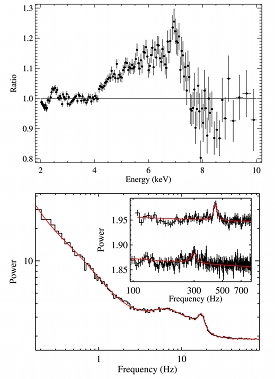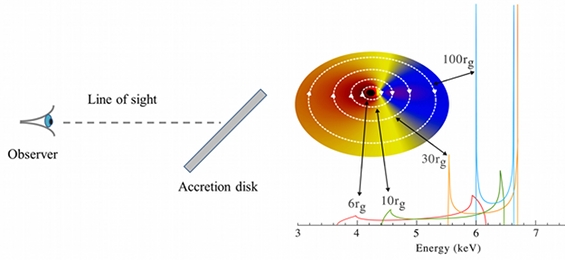Determining Strong Gravity Effects with LOFT
The two most important direct diagnostics of strong-field gravity near stellar-mass Black Holes in X-ray binaries (XRB) and supermassive Black Holes in Active Galactic Nuclei (AGN) that LOFT will use are relativistically broadened iron (Fe) lines and relativistic time-scale variability, in particular, quasi-periodic oscillations, QPOs.
 |
| Complementary measurements by LOFT - broadened iron line emission (above) is obtained simultaneously with power measured at different oscillation frequencies (below). Credit: ESA |
LOFT will for the first time provide the spectral resolution required for the relativistic lines, combined with the photon throughput required to study their variability on time scales down to well below the dynamical time scale of the strong field region. The very broad Fe-Kα profiles reliably observed in both AGN and XRB have been successfully modelled by X-ray reprocessing of an energetic irradiating source of X-rays by the plasma in an accretion disc in tight relativistic orbits around the Black Hole.
At the same time as the X-ray spectrum is measured, highlighting the broadened energy spectrum of iron line emission from the black hole, the time signature at different oscillation frequencies is measured, and the power at different frequencies provides an unambiguous value for the orbital periods in the accreting material.
Because the 'spectral timing' techniques used to analyze these rapid line profile variations essentially combine three orthogonal diagnostics of the flow and its geometry, namely, (i) spectroscopy yielding velocities and redshift, (ii) timing of orbiting patterns revealing orbital periods in the disc and (iii) reverberation providing absolute length scales, they yield unprecedented insight in the processes in the inner flow.
 |
| Coloured disc map illustrates the red- and blue-shifts as seen from the observer that result from these effects. Fe line profiles contributed by different orbital radii in the accretion disc are illustrated. Realistic models for the Fe line profile include a description of geometry and ionization state of the disc plasma and can constrain gravitational potential, plasma motions, and Black Hole spin. Credit: ESA |
